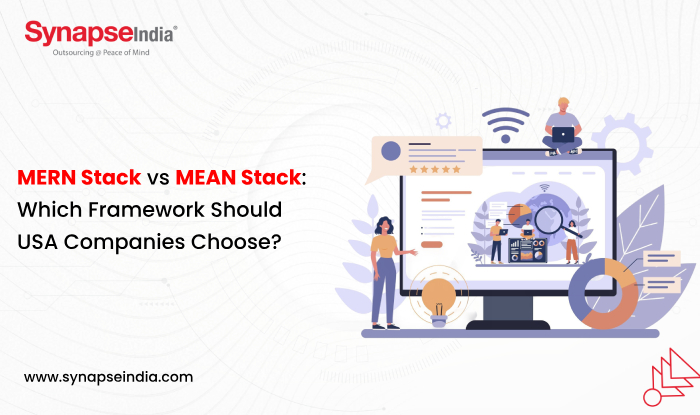 30 Oct 2025
30 Oct 2025
In 2025, full-stack developers in the USA earn a median salary of $119,000 per year (Medium). That shows how valuable JavaScript-based web development has become.
But many USA companies still face one key decision: Should they choose the MEAN stack or the MERN stack? Both use JavaScript for front-end and back-end development, but each fits different project goals.
We help USA businesses pick the right path; MEAN for structured systems, MERN for dynamic, fast-moving apps.

The MEAN stack is a combination of MongoDB, Express.js, Angular, and Node.js. It provides a complete environment for building scalable web applications.
Here’s what each layer does:
We often recommend MEAN Stack Development Services in USA for applications that require a well-defined structure, such as enterprise or internal systems. Its organized approach helps maintain consistency across large projects.
MERN stands for MongoDB, Express.js, React, and Node.js. The main difference is React, which replaces Angular on the front end. Here’s how it works:
MERN Stack Development Services in USA often favor this setup because React allows flexible integration of additional tools. For USA businesses aiming for interactive web apps or fast user interfaces, MERN Stack Web App Development offers excellent adaptability.
Both stacks share MongoDB, Express.js, and Node.js but differ in the front-end technology. Here’s how they compare:
In short, MEAN Stack App Development suits enterprise-grade systems, while MERN Stack Development Services fit projects that demand faster updates and flexibility.
The choice depends on the project type and business goals.
We guide USA companies to choose based on their long-term plans. MERN works best for rapid prototyping, while MEAN fits steady, complex workflows.
The growing focus on mobile and responsive design has increased MERN’s popularity. With over 63% of USA’s web traffic now coming from mobile devices (Statista), React’s component-based system helps build responsive, efficient interfaces.
Meanwhile, MEAN continues to serve well for internal systems and structured applications. As businesses integrate AI-driven tools, MERN’s flexibility makes it easier to adapt and evolve quickly.
At SynapseIndia, we have successfully built over 5,000 web applications using both stacks. Our experts understand when to apply MEAN’s organized framework or MERN’s agility based on project goals. We provide end-to-end support to USA clients, combining technical expertise with business understanding.
Contact us today for MEAN Stack Development Services or MERN Stack Development Company in USA to discuss your next project.

Both MEAN and MERN stacks are excellent choices for web app development. MEAN supports large-scale, structured applications, while MERN allows faster updates and flexible interfaces.
For USA companies, the decision depends on project needs, team size, and timeline. MEAN offers order and reliability; MERN adds speed and adaptability. Both will continue shaping modern web solutions in 2025 and beyond.
Yes, MERN is easier to start with since React focuses on reusable components and has a shorter learning curve.
Not always. MEAN suits structured inventory systems, but MERN fits dynamic sites with frequent updates.
MERN developers usually cost 5–10% less due to higher availability, while MEAN developers charge more for enterprise experience.
No, Angular continues to evolve and remains popular for large-scale applications.
Yes, hybrid setups are possible by using MEAN’s back end with MERN’s front end to combine both benefits.

 09 Mar 2023
09 Mar 2023
